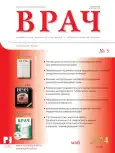The effect of nonsteroidal anti-inflammatory drugs on cartilage tissue
- Authors: Potupchik Т.V.1, Kapustina E.V.1,2, Klyuchnikova Е.P.1,2, Oskina V.V.1
-
Affiliations:
- Prof. V.F. Voino-Yasenetsky Krasnoyarsk State Medical University, Ministry of Health of Russia
- Krasnoyarsk Regional Clinical Hospital
- Issue: Vol 35, No 5 (2024)
- Pages: 45-48
- Section: Pharmacology
- URL: https://journals.eco-vector.com/0236-3054/article/view/633291
- DOI: https://doi.org/10.29296/25877305-2024-05-07
- ID: 633291
Cite item
Abstract
The article presents a review of studies on the effect of nonsteroidal anti-inflammatory drugs (NSAIDs) on cartilage tissue. Most studies have shown that non-selective NSAIDs, especially with prolonged use, negatively affect cartilage, accelerate cartilage destruction, inhibit prostaglandin synthesis, chondrocyte proliferation, and inhibit enzymes necessary for the synthesis of glycosaminoglycans. Cyclooxygenase-2 selective drugs have a positive effect on the condition of the cartilage matrix. However, taking into account some contradictions and insufficient information from the scientific literature of recent years, the need for further scientific research in this direction is emphasized.
Full Text
About the authors
Т. V. Potupchik
Prof. V.F. Voino-Yasenetsky Krasnoyarsk State Medical University, Ministry of Health of Russia
Author for correspondence.
Email: potupchik_tatyana@mail.ru
Сandidate of Medical Sciences
Russian Federation, KrasnoyarskE. V. Kapustina
Prof. V.F. Voino-Yasenetsky Krasnoyarsk State Medical University, Ministry of Health of Russia; Krasnoyarsk Regional Clinical Hospital
Email: potupchik_tatyana@mail.ru
Сandidate of Medical Sciences
Russian Federation, Krasnoyarsk; KrasnoyarskЕ. P. Klyuchnikova
Prof. V.F. Voino-Yasenetsky Krasnoyarsk State Medical University, Ministry of Health of Russia; Krasnoyarsk Regional Clinical Hospital
Email: potupchik_tatyana@mail.ru
Russian Federation, Krasnoyarsk; Krasnoyarsk
V. V. Oskina
Prof. V.F. Voino-Yasenetsky Krasnoyarsk State Medical University, Ministry of Health of Russia
Email: potupchik_tatyana@mail.ru
Russian Federation, Krasnoyarsk
References
- Чичасова Н.В. Нестероидные противовоспалительные препараты в лечении остеоартрита: проблема выбора с учетом безопасности и влияния на хрящ. Consilium Medicum. 2017; 19 (9): 122–8 [Chichasova N.V. Nonsteroidal anti-inflammatory drugs in the treatment of osteoarthritis: the problem of choice in terms of safety and impact on cartilage. Consilium Medicum. 2017; 19 (9): 122–8 (in Russ.)]. doi: 10.26442/2075-1753_19.9.122-128
- Castaneda S., Roman-Blas J.A., Largo R. et al. Subchondral bone as a key target for osteoarthritis treatment. Biochem Pharmacol. 2012; 83: 315–23. doi: 10.1016/j.bcp.2011.09.018
- Pan J., Zhou X., Li W. et al. In situ measurement of transport between subchondral bone and articular cartilage. J Orthop Res. 2009; 27: 1347–52. doi: 10.1002/jor.20883
- Lories R.J., Luyten F.P. The bone-cartilage unit in osteoarthritis. Nat Rev Rheumatol. 2011; 7 (1): 43–9. doi: 10.1038/nrrheum.2010.197
- Roman-Blas J., Herrero-Beaumont G. Targeting subchondral bone in osteoporotic osteoarthritis. Arthritis Res Ther. 2014; 16 (6): 494. doi: 10.1186/s13075-014-0494-0
- Струков В.И. Мировое открытие в борьбе с переломами и остеопорозом! Поликлиника. 2012; 5: 126–7 [Strukov V.I. A world discovery in the fight against fractures and osteoporosis! Policlinika. 2012; 5: 126–7 (in Russ.)].
- Doherty M. Chondroprotection by nonsteroidal anti-inflammatory drugs. Ann Rheum Dis. 1989; 48: 619–21. doi: 10.1136/ard.48.8.619
- Brandt K.D. The mechanism of action of nonsteroidal antiinflammatory drugs. J Rheumatol Suppl. 1991; 27: 120–1.
- Ostensen M. Cartilage changes in arthritis do non-steroidal antiphlogistics have positive or negative effects? Tiddsskr-Nor-Laegeforen. 1991; 111: 838–40.
- Meyer-Carrive I., Ghosh P. Effects of tiaprofenic acid (Surgam) on cartilage proteoglycans in the rabbit joint immobilization model. Ann Rheum Dis. 1992; 51: 448–55. doi: 10.1136/ard.51.4.448
- Blot L., Marcelis A., Devogelaer J.P. et al. Effects of diclofenac, aceclofenac and meloxicam on the metabolism of proteoglycans and hyaluronan in osteoarthritic human articular cartilage. Br J Pharmacol. 2000; 131 (7): 1413–21. doi: 10.1038/sj.bjp.0703710
- Ding C. Do NSAIDs affect the progression of osteoarthritis? Inflammation. 2002; 131: 1413–21. doi: 10.1023/a:1015504632021
- Makherje P., Rachita C., Aisen P.S. et al. Non-steroidal anti-inflammatory drugs protect against chondrocyte apoptotic death. Clin Exp Rheimatol. 2001; 19 (1 Suppl 22): S7-S11.
- Yang S.F., Hsieh Y.S., Lue K.H. et al. Effects of nonsteroidal anti-inflammatory drugs on the expression of urokinase plasminogen activator and inhibitor and gelatinases in the early osteoarthritic knee of humans. Clin Biochem. 2008; 41 (1-2): 109–16. doi: 10.1016/j.clinbiochem.2007.10.011
- Kullich W., Fagerer N., Schwann H. Effect of the NSAID nimesulide on the radical scavenger glutathione S-transferase in patients with osteoarthritis of the knee. Curr Med Res Opin. 2007; 23 (8): 1981–6. doi: 10.1185/030079907X223486
- Abrams G.D., Chang W., Dragoo J.L. In Vitro Chondrotoxicity of Nonsteroidal Anti-inflammatory Drugs and Opioid Medications. Am J Sports Med. 2017; 45 (14): 3345–50. doi: 10.1177/0363546517724423
- Hajjaji E.I., Marcells A., Devogelaer J.P. et al. Celecoxib has a positive effect on the overall metabolism of hyaluronan and proteoglycans in human osteoarthritic cartilage. J Rheumatol. 2003; 30 (11): 2444–51.
- Mastbergen S.C., Lafeber F.P., Bijlsma J.W. Selective COX-2 inhibition prevents proinflammatory cytokine-induced cartilage damage. Rheumatology (Oxf). 2002; 41: 801–8. doi: 10.1093/rheumatology/41.7.801
- Mastbergen S.C., Jansen N.W., Bijlsma J.W. et al. Differetial direct effects of cyclo-oxygenase-1/2 inhibition on proteoglycan turnover of human osteoarthritic cartilage: an in vitro study. Arthritis Res Therapy. 2006; 8: R2. doi: 10.1186/ar1846
- Mastbergen S.C., Bijlsma J.W., Lafeber F.P. Selective COX-2 inhibition is favorable to human early and late-atage osteoarthritis: a human in vitro study. Osteoarthritis Cartilage. 2005; 13: 519–26. doi: 10.1016/j.joca.2005.02.004
- Janssen M.P., Caron M.M., van Rietbergen B. et al. Impairment of the chondrogenic phase of endochondral ossification in vivo by inhibition of cyclooxygenase-2. Eur Cell Mater. 2017; 34: 202–16. doi: 10.22203/eCM.v034a13
- Efstathiou M., Settas L. The effect of non-steroidal anti-inflammatory drugs on matrix metalloproteinases levels in patients with osteoarthritis. Mediterr J Rheumatol. 2017; 28 (3): 133–41. doi: 10.31138/mjr.28.3.133
- Эверт Л.С., Потупчик Т.В., Костюченко Ю.Р. и др. Постковидные поражения скелетно-мышечной системы у подростков: подходы к фармакотерапии. Врач. 2022; 33 (8): 11–8 [Evert L.S., Potupchik T.V., Kostyuchenko Y.R. et al. Post-COVID-19 lesions of the musculoskeletal system in adolescents: approaches to pharmacotherapy. Vrach. 2022; 33 (8): 11–8 (in Russ.)]. doi: 10.29296/25877305-2022-08-02
- Парфенов В.А. Причины, диагностика и лечение боли в нижней части спины. Неврология, нейропсихиатрия, психосоматика. 2009; 1: 19–22 [Parfenov V.A. Low back pain: causes, diagnosis, and treatment. Neurology, Neuropsychiatry, Psychosomatics. 2009; 1: 19–22 (in Russ.)]. doi: 10.14412/2074-2711-2009-17
- Merkely G., Chisari E., Lola Rosso C. et al. Do Nonsteroidal Anti-Inflammatory Drugs Have a Deleterious Effect on Cartilage Repair? A Systematic Review. Cartilage. 2021; 13 (1 suppl): 326S-341S. doi: 10.1177/1947603519855770
Supplementary files






